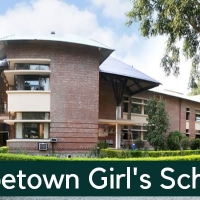Hopetown Girls School in Dehradun, Uttarakhand Admission, Fees Structure

Where is Hopetown Girls School ?
Hopetown Girls School is Located in Dehradun , Uttarakhand, India
Address of Hopetown Girls School, Dehradun
Rajawala Road, P.O. Selaqui,
Dehradun 248011,
Uttarakhand, India
0135-2698554, 0135-2699521,
0135-2698022
schooloffice@hopetown.in
admissions@hopetown.in
How do I contact Hopetown Girls School?
Call at +91-9068716020 to contact Hopetown Girls School
About Hopetown Girls School
"The fifty-acre school campus is in a picturesque valley near Dehradun. It is surrounded by a sal forest and a view of the lower Mussoorie hills to the north. The sprawling games fields, gardens and school buildings create a space that is inviting and invigorating.The founder of Hopetown Girls’ School, Mr Kamal Sehgal’s primary objective was to build a school for five hundred girls and to develop an infrastructure for them, over the years. He has done just that. He was clear that he wanted his school to be a happy place for children to grow up in and chose a “happy girl” for the school’s logo.The school’s overall curriculum is designed to be stimulating. Teachers use the latest pedagogies in planning their lessons, focusing on the need to make learning relevant to the children. Technology is central to the teaching, learning process. The school also believes that the Arts contribute positively to the development and happiness of children and therefore provides unique facilities for the Performing and Fine Arts.Hopetown is very conscious of the role women play in society and aims to develop confident young women with vision and the potential to meet challenges with confidence."
The city is noted for its picturesque landscape and slightly milder climate and provides a gateway to the surrounding region It is well connected and in proximity to Himalayan tourist destinations such as Mussoorie, Dhanaulti, Chakrata, New_Tehri, Uttarkashi, Harsil, Chopta - Tungnath, Auli, India, famous summer and winter trekking destinations like Dodital, Dayara Bugyal, Kedarkantha, Har Ki Dun for camping and grandeur Himalayan panoromic views The Hindu holy cities of Haridwar and Rishikesh along with the Himalayan pilgrimage circuit of Chota Char Dham ie Yamunotri, Gangotri, Kedarnath and Badrinath.
Dehradun is also known for its Basmati rice and bakery products Dehradun is a notable academic and research hub and is home to Indian Military Academy, Rashtriya Indian Military College, Uttarakhand Ayurveda University, Forest Research Institute, Wadia Institute of Himalayan Geology, and Indira Gandhi National Forest Academy According to the combined survey based on health, infrastructure, economy, education and safety; conducted by Dainik Jagran and KPMG, Dehradun is one of the safest cities to live in The city stands at an elevation of approximately 700 metres (2,300 ft) above sea level Also known as the ‘Abode of Drona’, Dehradun has been an important centre for Garhwal rulers which was captured by the British.
Often referred as the gateway to Mussorie Uttarakhand Police is the main law enforcement agency in the city
The winter capital of Uttarakhand is Dehradun, the largest city of the state, which is a rail head Gairsain, a town in Chamoli district is the summer capital of Uttarakhand The High Court of the state is located in Nainital Archaeological evidence supports the existence of humans in the region since prehistoric times The region formed a part of the Uttarakuru Kingdom during the Vedic age of Ancient India.
Among the first major dynasties of Kumaon were the Kunindas in the 2nd century BCE who practised an early form of Shaivism Ashokan edicts at Kalsi show the early presence of Buddhism in this region During the medieval period, the region was consolidated under the Katyuri rulers of Kumaon also known as 'Kurmanchal Kingdom' After the fall of Katyuris, the region was divided into the Kumaon Kingdom and the Garhwal Kingdom In 1816, most of modern Uttarakhand was ceded to the British as part of the Treaty of Sugauli.
Although the erstwhile hill kingdoms of Garhwal and Kumaon were traditional rivals, the proximity of different neighbouring ethnic groups and the inseparable and complementary nature of their geography, economy, culture, language, and traditions created strong bonds between the two regions, which further strengthened during the Uttarakhand movement for statehood in the 1990s The natives of the state are generally called Uttarakhandi, or more specifically either Garhwali or Kumaoni by their region of origin According to the 2011 Census of India, Uttarakhand has a population of 10,086,292, making it the 20th most populous state in India